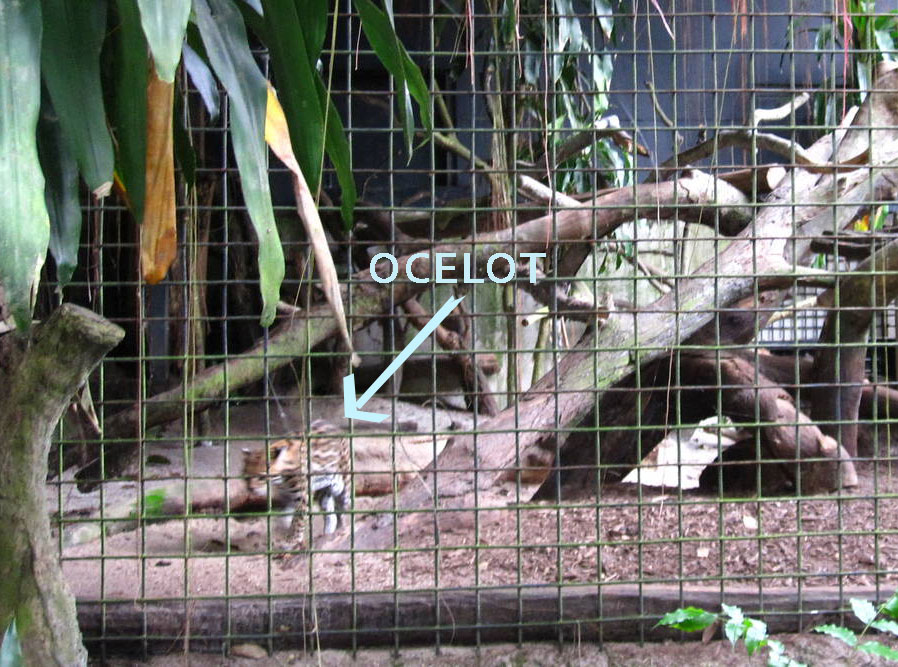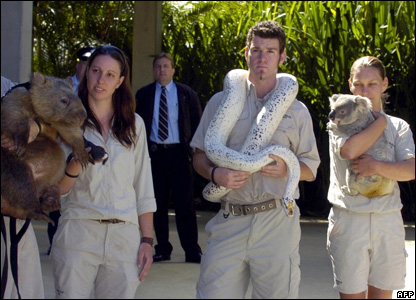Once upon a time I was asked to go to one of the most prestigious zoos in the country as a consultant. They are so prestigious that I was not allowed to refer to myself as a consultant. The behavior director gave me an intimate tour that included going past an adult ocelot in a long, narrow ‘natural’ cage about 30 yards long and 6 yards wide. The cat stayed at one end. He would leap up on the fence, leap to the corner fence, drop to the ground, head toward his starting point and do it again…and again…and again. The cat was clearly mad from confinement. Why was it on display? To attract customers. It was the only ocelot they had.
I told the behavior director that I could fix the problem. He asked how. I told him. When I got to the part about using aversive control, he looked as if I had suggested letting the cat actually hunt for food while customers could see it. This same zoo had a wolf with lick granuloma, a hyacinth macaw that couldn’t be displayed because it bit fingers and an elephant that had killed a keeper. None of this mattered because they had a world-class ‘enrichment’ program. They used ‘marine mammal training’ and mentally stimulated the animals to make them happy.
You would be hard pressed to find a behavioral scientist who doesn’t believe in evolution. You would have an even harder time finding one who understands what that implies. While they do not challenge the concept that animals developed via the lathe of nature carving away the inadaptable, their concept of “enrichment” studiously avoids that reality. In nature, the constant struggle to avoid danger and the constant struggle to achieve some goal is the rule, not the exception. Animals that replicated themselves possessed innate abilities to deal with that kind of life. Why would a life of leisure be healthy for them? Why would removing all stress be a good thing? Why remove an ingredient so important to the survival of their species that it made them what they are – because it fits their image of being nice. It’s not about the animals. It’s about them.
That is why the try so desperately to confine animals in ‘one environment fits all’. Not only do they ignore that today’s animals developed and specialized over millions of years, the think that all animals should live in an ideologically imagined world of ‘nice’ – something that does not exist in nature. They have captive lions that never have to dodge the horns of a Cape buffalo. Giraffes in captivity never have to run from lions. Hyenas never have to defend a kill and wildebeest don’t have to migrate. No, the modern biologist thinks that captive animals go crazy for want of puzzles and novelties that bring ‘positive reinforcement’. They call this process ‘enrichment’ and pat themselves on the back for keeping terribly confined animals mentally stimulated…in only one way. That many of their animals suffer from mental disorders doesn’t bother them. They just take them off-display and use them to replicate genes that spoil their keepers fantasy world. Many of these animals aren’t nice, don’t like nice and know what to do when another animal isn’t nice – and none of that will ever be seen at a major zoo or aquarium.
The problem with this perspective is that all the various species are driven to do what their ancestors did in order to create their genes. Lions hunt. Lions fight. Lions kill and eat prey. Hyenas fight lions and lions try to steal hyena kills whenever they can. At some point, every predator gets terrified by serious competitors. None of that happens at a zoo. None of that happens at your home. Creating a ‘perfect world’ for animals is seriously lopsided. It’s based on a fantasy. It clearly doesn’t work – and they will attack anyone who says so. The Emperor wasn’t happy when his nakedness was exposed. In the zoo world the clothes are usually khaki and have logo patches on them, but it’s the same kind of fantasy.
